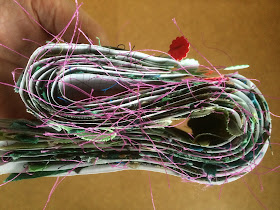Sorry for the delay.
There has been a lot to learn since last week's lesson. I have worked hard at the set homework.
Let's start with the monogram on the tea towel.

I stitched it with a piece of waste canvas, which helped to keep the stitches even.

After stitching, I sprayed the canvas with water, waited until the starched threads had softened and picked them out with a pair of tweezers.

I am quite pleased with the result.

By paying attention I managed to make the back rather even, too. Most stitches are vertical and the crosses or horizontally drawn threads are few.
I am the student of this course, but in a way also the teacher, so I will give myself 'Well Done' for this part of the homework.
The free pattern
The object with this homework was to make the thread lie flat on the cross and the back look neat.
I added another target, to make individual stitches without the thread traveling on the back.
The first thing I did was to separate the two threads by pulling them out one by one from the six strands of floss. This is also known as '
stripping'.
Since then I have been given the advice by
Carorose to dampen the strands with a sponge before threading the needle. I have yet to try this, but Carorose is a highly professional needlewoman and have made more Cross Stitch work than anyone I know.
I paid attention to check that the two threads were parallel even in the first part of the cross.
I did this with a tip I once got from a Japanese embroidery book -
roll the needle between the thumb and index finger to untangle the threads. I blogged about this back in 2013.
I think this method works rather well.
Next let's focus on individual Cross Stitches without the thread traveling on the back.
Begin by anchoring the stitch like this:
Then make the Cross Stitch itself.
Finally anchor the stitch under the Cross Stitch.
Snip off the thread ends on the back.
The completed piece.
So how does it look on the back?
Well, certainly better than my previous work!
I think the Cross Stitch is one stitch I no longer need to get crossed with!





























